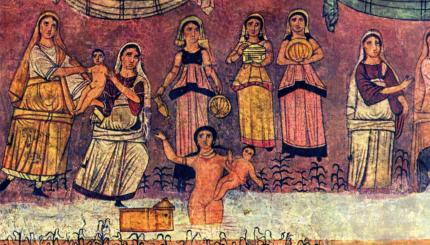Tucked away, among a pile of folders and spiral notebooks that contain the photocopied sources and notes of classes gone by is a manila folder that makes me smile every time I come across it. Therein lie my careful notes from what we knew as “the machshavah shiur,” a class in religious ideas given by Rav Aharon Lichtenstein zt”l, before his weekly shiur at Gruss Kollel in Jerusalem.
In the early nineties, for the academic year when I attended the shiur religiously, R. Lichtenstein zt”l diverged from the known text of that time slot (Pirkei Avot/Ethics of the Fathers) and taught Ramban’s commentary on the instead. Among the insights that have stayed with me without needing to check my notes are the parallels he drew between Ramban’s commentary on the Torah and the interpretive and analytic efforts of the Baalei HaTosafot on the Talmud. Because Rashi and his comprehensive line-by-line commentaries preceded both endeavors, both Ramban and the Baalei HaTosafot were free, as it were, to investigate at will, penning passages – mini essays, if you will – on meta concerns of meaning.
Women were welcome to attend the machshavah shiur. A few large, round tables were set up, usually on one side of a large room, to accommodate the female attendees. Women were also welcome to attend the Talmud shiur, and for many years, there were several women who did just that. For about a year and a half, a pair of my friends stayed for the Talmud class, together with twenty Gruss guys and another three women. Then…in the interest of peace, R. Lichtenstein zt”l responded at last to the discomfort of some of the men in the shiur who were less receptive to the women’s presence there than he himself was, and the women were asked to stop attending. That R. Lichtenstein zt”l supported the women’s Torah learning is indisputable, however.
I emphasize this point because over the course of the past week, I have heard beautiful, inspiring tear-jerking eulogies, and the occasional lament that women did not know R. Lichtenstein zt”l. Leaving aside the obvious point that a men’s rosh yeshivah will logically and necessarily leave more male students than female, I have a deep desire to shake those who lament, and say to them that they simply don’t know the right people, and they aren’t reading R. Lichtenstein zt”l’s words.
*****************
A case in point: a woman who first moved to Alon Shevut to live in the “kollel buildings” with her new husband in the mid-nineties. Even then, before these long twenty years under R. Lichtenstein zt”l’s close influence, she quoted him to me to explain how she wasn’t taking on all of her husband’s practices: “R. said….” Words that I heard repeated often. And now her articulation of the profundity of this loss speaks for itself:
In “The Source of Faith is Faith Itself,” Rav Lichtenstein writes about those who, beyond simply shaping his ideology, were the living embodiments of the faith experience for him, indelibly influencing and shaping his own faith experience by their mere presence and intrinsic essence.
For me, that person was HaRav Aharon Lichtenstein.
*****************
A case in point: a young woman whose education prior to Stern College did not include the learning she attained there, and undermined her confidence as to whether she truly ought to be learning, and then preparing to teach, Talmud. When she discovered that R. Lichtenstein zt”l was to speak on women and talmud Torah at Manhattan’s Jewish Center, she decided to ask him about it. I was there at the shiur – he delineated the history and halakhic issues pertaining to women learning Torah, and what emerged was – to me – a profound and inspiring endorsement. If only it hadn’t been Shabbos…I’d be glad to add notes from that day to my manila folder!
But here’s what’s important: after the shiur, he then engaged with this young woman’s question seriously, and discussed the issues with her for eighteen long New York City blocks, as she accompanied him to his next engagement at Lincoln Square Synagogue. He didn’t pasken for her. She didn’t become a close student of his. But – despite her concern that she was monopolizing his time – R. Lichtenstein zt”l focused on her, treating her concerns with as much rigor and respect as due any serious inquiry. She might have preferred a more definitive “go forth and teach” (she does; she’s excellent), but I’m so pleased to know she was not dismissed in any way, not even with positive words.
*****************
It is not insignificant that many of the serious institutions of women’s Torah study have enjoyed some serious measure of R. Lichtenstein zt”l’s influence. Drisha’s founder Rabbi David Silber maintains that R. Lichtenstein zt”l was his first rebbe. He was among the rabbinic authorities backing Matan. And, of course, he was a presence at what surely has been a showcase for women’s batei midrash since its inception, Migdal Oz, founded not surprisingly by R. Lichtenstein zt”l’s daughter, Esti Rosenberg.
Nor is it insignificant that many of the men who have undertaken to teach women Torah (Talmud in particular, but not only) on both sides of the Atlantic Ocean are alumni of Yeshivat Har Etzion. They carry R. Lichtenstein zt”l’s training and influence with them, and it will surely proliferate and spread in ways as yet unknown, as an ever increasing number of women study under them, counting themselves among the circles of learners.
Which is not to say that R. Lichtenstein zt”l was trumpeting a clarion call for women learning Torah. Rather – he didn’t. The prophet Elisha teaches us that the still, small voice in the wilderness is often the most powerful in rallying people to God. R. Lichtenstein zt”l learned and he taught and he led, granting respect to all who were engaged in the same. Women and men. Without fanfare.
It strikes me that it’s the same approach that brought Esti Rosenberg and Toni Mittelman to eulogize their father, as they also gave shiurim at the eightieth birthday celebration in his honor last year. That is, naturally and without fanfare, each took her place, in order of age, to speak, to mourn together with the community that shares their loss. It was presented as a given, and smoothly: children eulogizing their father. More’s the shame that it begs comment.
And more is the shame that there is a need to articulate R. Lichtenstein zt”l’s influence on women – for whom he served as a model of greatness, in his being and in his writings (go read them, and be enriched), just as he did for men – and with regard to the matters that are treated as if they pertain to women only. My sense is that here is where we go wrong: if R. Lichtenstein zt”l was able to respond with respect to all who sought Torah and to all matters of Torah, regardless of gender, then that is moving legacy enough.



